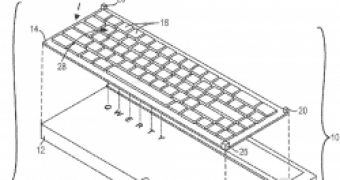Microsoft is trying to patent a new keyboard, one that features configurable keys and which would enable multiple different key arrangements.
Basically, the company is working on producing a keyboard that sports integrated screens inside each key, so that they could be set up for use with different roles when needed.
The Redmond-based giant has already submitted an application for the patent with the United States Patent and Trademark Office, and details on the device can be extracted from this filing.
In the abstract of the application, Microsoft describes a keyboard kit “that is selectively configurable by an end user to provide differing key arrangements is provided.”
The company also notes that “the keyboard kit includes a plurality of differently-configured keyboard modules and an underlying display device.”
Each of these would be see-through at least partially, and would sport mechanically depressible keys, along with the said underlying display device.
Microsoft notes that the plurality of differently configured keyboard modules would be set so that, upon securing one of these modules to the underlying display device, the module covers “at least a portion of an operative surface” of the display device “and enables through-key user viewing of dynamic keyboard imagery” from it.
Microsoft’s vision of such a device appears radically different from similar concepts that have been already seen on the web: the company proposes that the display would be place below the physical key, which some suggest would limit the viewing angle toward the key.
The fact that Microsoft is trying to patent the said keyboard does not necessarily mean that the company is also working on bringing it to shelves, though there is a strong possibility that it would do so.
For some, it might seem strange that the software giant is working on improving the market of keyboards, especially since it has been focused on optimizing its products for use on touch screens by implementing the Metro UI in many of these.

 14 DAY TRIAL //
14 DAY TRIAL //